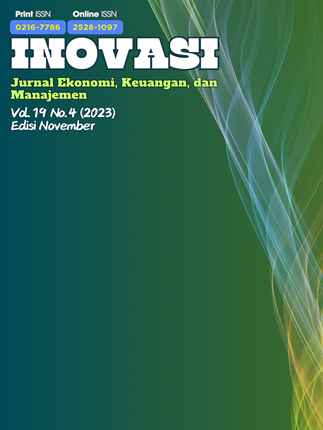The relation of group dynamics with the effectiveness of a team in an organization
DOI:
https://doi.org/10.30872/jinv.v19i4.2483Keywords:
Group dynamics, team effectiveness, organizationsAbstract
The group dynamic is crucial for organizations in a highly competitive business environment. It signifies that each member successfully contributes to the shared goal. But, explaining in a group requires a separate point of view in order to comprehend what is going on and to focus on many people, each with their own unique perspective and response to the activity that was taking place. The purpose of this study is to examine the relationship between group dynamics with the team effectiveness in the organization. This study uses various perspectives from the previous literature until the present relating group dynamics and team effectiveness. This study provides general information about the studies on group dynamics and team effectiveness in organizations
References
Akrivou, K., Boyatzis, R. E., & McLeod, P. L. (2006). The evolving group: Towards a prescriptive theory of intentional group development. Journal of Management Development, 25(7), 689–706. https://doi.org/10.1108/02621710610678490
Arative, A., Tive, A. N., Al, A. L., Aly, A. L., Erma, E., Santosh, S. R., Santosh, R., & Kumar Barua, M. (n.d.). TEAM EFFECTIVENESS IN INDIAN ORG. In Delhi Business Review X (Vol. 13, Issue 2).
Campion, M. A., Medsker, G. J., & Higgs, A. C. (1993). Relations Between Work Group Characteristics And Effectiveness: Implications For Designing Effective Work Groups. Personnel Psychology, 46(4), 823–847. https://doi.org/10.1111/j.1744-6570.1993.tb01571.x
Carter, K. M., Mead, B. A., Stewart, G. L., Nielsen, J. D., & Solimeo, S. L. (2019). Reviewing Work Team Design Characteristics Across Industries: Combining Meta-Analysis and Comprehensive Synthesis. Small Group Research, 50(1), 138–188. https://doi.org/10.1177/1046496418797431
Choi, J. N. (2002). External Activities and Team Effectiveness. Small Group Research, 33(2), 181–208. https://doi.org/10.1177/104649640203300202
Cohen, S. G., & Bailey, D. E. (1997). What Makes Teams Work: Group Effectiveness Research from the Shop Floor to the Executive Suite. Journal of Management, 23(3), 239–290. https://doi.org/10.1177/014920639702300303
Fransen, J., Kirschner, P. A., & Erkens, G. (2011). Mediating team effectiveness in the context of collaborative learning: The importance of team and task awareness. Computers in Human Behavior, 27(3), 1103–1113. https://doi.org/10.1016/j.chb.2010.05.017
Fung, H.-P. (2014). To Cite This Article: Han-Ping Fung, Relationships among Team Trust, Team Cohesion, Team Satisfaction, Team Effectiveness and Project Performance as Perceived by Project Managers in Malaysia. In Australian Journal of Basic and Applied Sciences (Vol. 8, Issue 8). www.ajbasweb.com
Gençer, H. (2019). Group dynamics and behaviour. Universal Journal of Educational Research, 7(1), 223–229. https://doi.org/10.13189/ujer.2019.070128
Gully, S. (2000). Work Teams Research Recent Findings and Future Trends.
Gupta, A. (n.d.). International Journal of Multidisciplinary Approach and Studies To Analysis the Role of Group Dynamics in Organization.
Hackman, J. R. (Ed.). (1990). Groups that work (and those that dont). Jossey-Bass. http://www.amazon.com/Groups-That-Work-Those- Dont/dp/1555421873/ref=sr_1_1?s=books&ie=UTF8&qid=1314379993&sr=1-1
Humphrey, S. E., Aime, F., Cushenbery, L., Hill, A. D., & Fairchild, J. (2017). Team conflict dynamics: Implications of a dyadic view of conflict for team performance. Organizational Behavior and Human Decision Processes, 142, 58–70. https://doi.org/10.1016/j.obhdp.2017.08.002
Isabel Delgado-Piña, M., María Romero-Martínez, A., & Gómez-Martínez, L. (n.d.). Designing effective teams: concept and measurement issues · esic market designing effective teams: concept and measurement issues.
Katzenbach, J., & Smith, D. (2005). The Discipline of Teams. Harvard Business Review, 71, 111–120.
Kelly, S., & MacDonald, P. (2019). A Look at Leadership Styles and Workplace Solidarity Communication. International Journal of Business Communication, 56(3), 432–448. https://doi.org/10.1177/2329488416664176
Koortzen, P., & Cilliers, F. (2002). The psychoanalytic approach to team development (pp. 220–235).
Kottler, J. A. (2010). Learning group leadership : an experiential approach (Matt. Englar-Carlson, Ed.; 2nd ed.) [Book]. SAGE.
Lewin, K., Lippitt, R., & White, R. K. (1939). Patterns of Aggressive Behavior in Experimentally Created “Social Climates.” The Journal of Social Psychology, 10(2), 269–299. https://doi.org/10.1080/00224545.1939.9713366
Mannix, E., & Neale, M. A. (2005). What Differences Make a Difference? Psychological Science in the Public Interest, 6(2), 31–55. https://doi.org/10.1111/j.1529-1006.2005.00022.x
Marks, M. A., Mathieu, J. E., & Zaccaro, S. J. (2001). A Temporally Based Framework and Taxonomy of Team Processes. Academy of Management Review, 26(3), 356–376. https://doi.org/10.5465/amr.2001.4845785
Mary, B. W. T., & Jensen, A. C. (1977). Group & Organization Studies (Vol. 2, Issue 4).
Mickan, S., & Rodger, S. (2000). Characteristics of effective teams:a literature review. Australian Health Review, 23(3), 201. https://doi.org/10.1071/AH000201
Mohanty, A. (2018). THE IMPACT OF COMMUNICATION AND GROUP DYNAMICS ON TEAMWORK EFFECTIVENESS: THE CASE OF SERVICE SECTOR ORGANISATIONS. In Academy of Strategic Management Journal (Vol. 17, Issue 4).
Naveenan, R. V. N., & Kumar, B. R. (2018). Impact of Group Dynamics on Team. American International Journal of Social Science Research, 2(2), 16–23. https://doi.org/10.46281/aijssr.v2i2.175
Olofu, P. A., Kanu, N. O., & Ugochigborogu, K. M. (n.d.). UNDERSTANDING THE DYNAMICS OF GROUP FORMATION AND ITS APPLICATION IN EDUCATIONAL ADMINISTRATION IN NIGERIA: THE PERSPECTIVE OF INTERACTION AND BALANCE THEORIES.
Oyefusi, F. (2022). Team and Group Dynamics in Organizations: Effect on Productivity and Performance. Journal of Human Resource and Sustainability Studies, 10(01), 111–122. https://doi.org/10.4236/jhrss.2022.101008
Reis, D. P. dos, & Puente-Palacios, K. (2019). Team effectiveness: the predictive role of team identity. RAUSP Management Journal, 54(2), 141–153. https://doi.org/10.1108/RAUSP-07-2018-0046
Rousseau, V., & Aubé, C. (2010). Team Self-Managing Behaviors and Team Effectiveness: The Moderating Effect of Task Routineness. Group & Organization Management, 35(6), 751–781. https://doi.org/10.1177/1059601110390835
Smith, C. (2005). Servant leadership : the leadership theory of Robert K. Greenleaf. Leadership Quarterly, 6.
Sundstrom, E., De Meuse, K. P., & Futrell, D. (1990). Work teams: Applications and effectiveness. American Psychologist, 45(2), 120–133. https://doi.org/10.1037/0003-066X.45.2.120
Weingart, L. R., Behfar, K. J., Bendersky, C., Todorova, G., & Jehn, K. A. (2015). The Directness and Oppositional Intensity of Conflict Expression. Academy of Management Review, 40(2), 235–262. https://doi.org/10.5465/amr.2013-0124
Downloads
Published
Issue
Section
License
Copyright (c) 2025 Nur Endah Ramayanti, Lorine Kalista Noor, Azi Nur Rahmasita, M. Iqbal Pribadi

This work is licensed under a Creative Commons Attribution-ShareAlike 4.0 International License.






